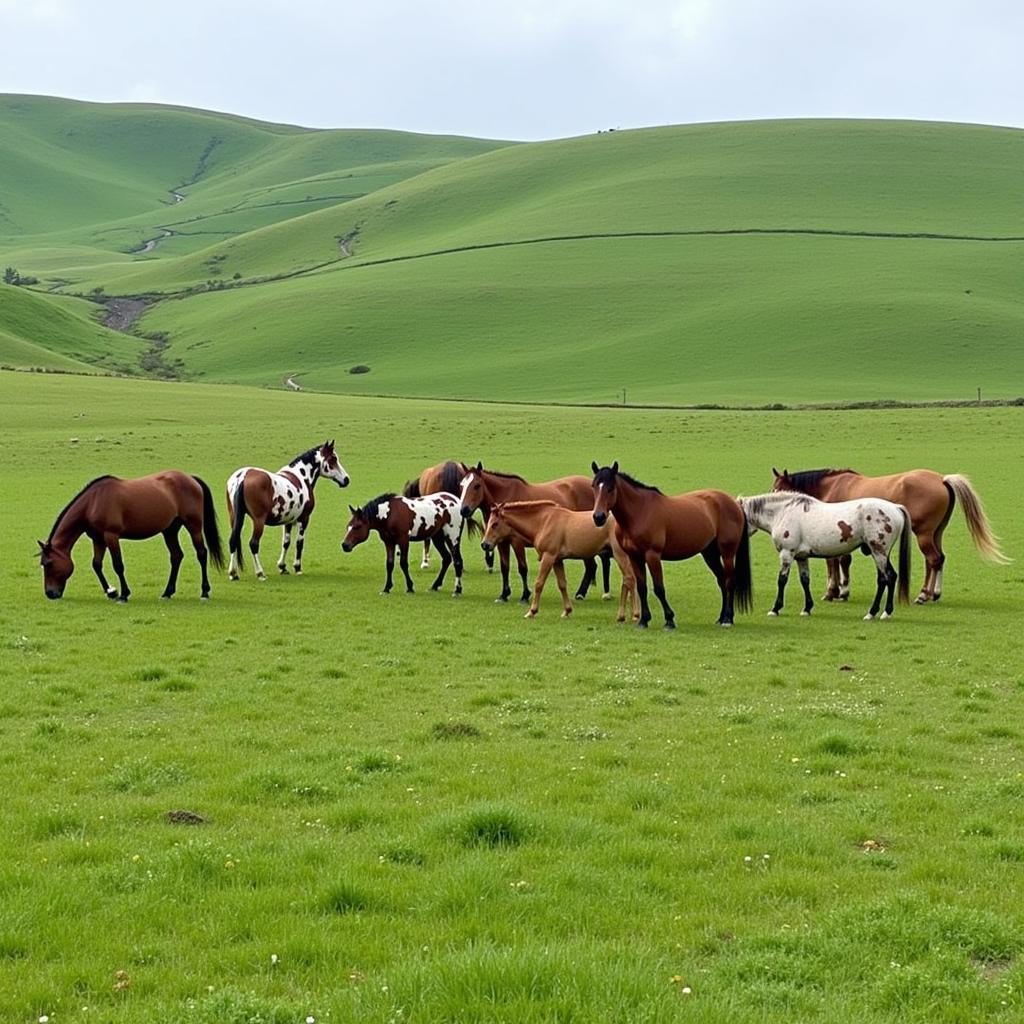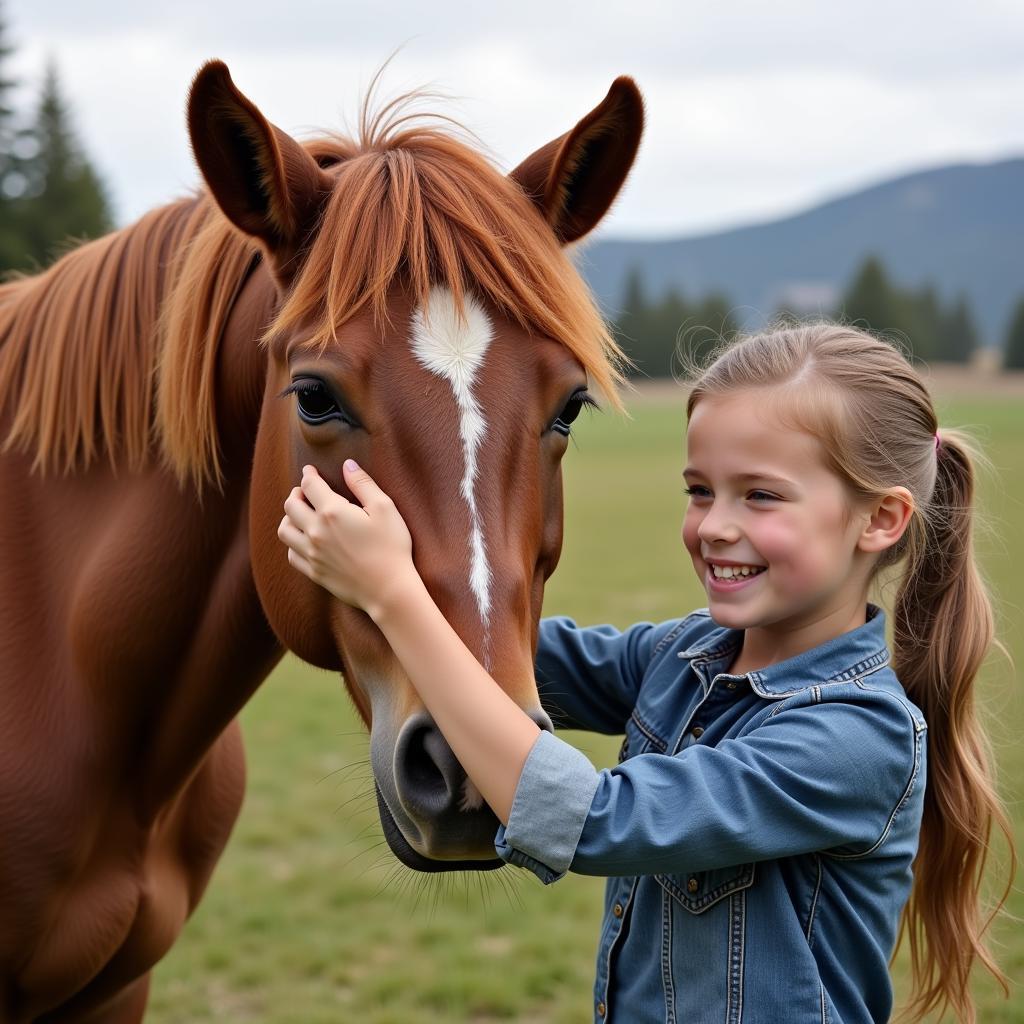The Palouse Horse, an iconic breed steeped in the rich history of the American West, evokes images of vast prairies and rugged landscapes. These majestic animals, with their distinctive spotted coats and gentle dispositions, have captivated horse enthusiasts for generations. Join us as we delve into the fascinating world of the Palouse horse, exploring its origins, characteristics, and enduring legacy.
 Palouse horse with a spotted coat standing on a hilltop against a backdrop of rolling hills and blue skies
Palouse horse with a spotted coat standing on a hilltop against a backdrop of rolling hills and blue skies
Tracing the Roots: The Palouse Horse’s Storied Past
The Palouse horse breed’s history is as intriguing as the horses themselves. Originating in the Palouse River region of Eastern Washington and Idaho, these horses are believed to be descendants of horses brought over by Spanish explorers in the 16th century. These early horses, primarily of Andalusian, Barb, and Arabian descent, were prized for their stamina, intelligence, and adaptability.
Over time, these horses intermingled with other breeds introduced by European settlers, resulting in the development of the unique Palouse horse we know today. These hardy animals thrived in the challenging terrain of the Palouse region, known for its rolling hills and harsh winters. They quickly became essential partners for early settlers, proving invaluable for farming, transportation, and even as war horses during the Nez Perce War.
 A herd of Palouse horses with various coat patterns grazing peacefully in a lush green pasture
A herd of Palouse horses with various coat patterns grazing peacefully in a lush green pasture
The Palouse Horse: A Tapestry of Unique Traits
The Palouse horse is easily recognizable by its distinctive spotted coat, a characteristic inherited from its Appaloosa ancestors. These spots, ranging in size and distribution, appear on a base coat that can vary from black, bay, chestnut, and even palomino. This unique coloration, combined with their striking conformation, makes them a favorite among horse lovers.
“The Palouse horse possesses an inherent hardiness that stems from its history of navigating the challenging Palouse terrain,” explains Dr. Emily Carter, a veterinarian specializing in equine genetics. “This, coupled with their calm temperament and willingness to work, makes them incredibly versatile companions.”
Beyond their striking appearance, Palouse horses are renowned for their intelligence, trainability, and calm demeanor. They are known for their smooth gaits, making them comfortable riding horses for both experienced equestrians and beginners. Their versatility extends beyond riding, as they excel in various disciplines, including driving, working cattle, and even participating in competitive trail riding.
Preserving a Legacy: The Fight to Save the Palouse Horse
Sadly, the Palouse horse, once a common sight in the American West, faced a drastic decline in numbers during the 20th century. Factors like mechanization in agriculture and crossbreeding with other breeds led to a dwindling population. Thankfully, dedicated breeders recognized the breed’s historical significance and exceptional qualities, sparking a movement to revive and preserve the Palouse horse.
 A young girl gently brushes the coat of a Palouse horse, showcasing the breed's gentle nature and suitability for all ages.
A young girl gently brushes the coat of a Palouse horse, showcasing the breed's gentle nature and suitability for all ages.
Through careful breeding programs and passionate advocacy, the Palouse horse is slowly regaining its footing. Organizations like the Palouse Horse Breeders Association are dedicated to promoting the breed, registering purebred horses, and educating the public about their importance.
Are you ready to own a piece of American history?
Owning a Palouse horse is more than just owning a horse; it’s about becoming part of a legacy. It’s about connecting with the spirit of the American West and ensuring the survival of a breed that played a vital role in shaping the region’s history. If you’re seeking a horse that embodies beauty, intelligence, and a heart of gold, look no further than the Palouse horse.
FAQ about Palouse Horses
- What is the average height of a Palouse horse? Palouse horses typically stand between 14.2 and 15.2 hands high.
- Are Palouse horses suitable for beginner riders? Yes, Palouse horses are known for their gentle temperament and willingness to learn, making them a good choice for beginner riders under proper guidance.
- Where can I find reputable Palouse horse breeders? The Palouse Horse Breeders Association website provides a directory of reputable breeders dedicated to preserving the breed’s standards.
- Are Palouse horses prone to any specific health issues? Like all horse breeds, Palouse horses may be susceptible to certain health conditions, but they are generally considered a healthy breed.
- Can I learn more about Palouse horse events and competitions? Absolutely! You can find information about Palouse horse shows, trail rides, and other events through the Palouse Horse Breeders Association.
Interested in exploring more about this remarkable breed or discovering other fascinating horse breeds? Check out our articles on horse camps in Idaho and the impressive Appaloosa horse stallion.
For any assistance, feel free to contact us:
Phone Number: 0772127271
Email: [email protected]
Address: QGM2+WX2, Vị Trung, Vị Thuỷ, Hậu Giang, Việt Nam.
We have a 24/7 customer service team ready to assist you.